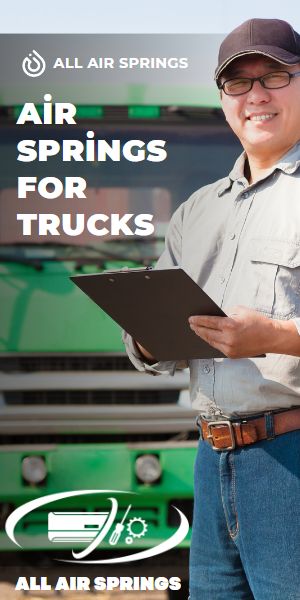
Introduction to Adjustable Cabin Air Springs
Adjustable cabin air springs are a key innovation in the automotive suspension system, designed to improve vehicle comfort and performance. These systems use air pressure to adjust the height and stiffness of the vehicle’s suspension, offering a smoother ride compared to traditional coil or leaf spring systems.
The primary function of adjustable cabin air springs is to optimize the ride quality by adapting to various road conditions and vehicle loads. Whether you’re navigating rough terrains, heavy traffic, or highway driving, these air springs help ensure that the vehicle maintains stability and minimizes the impact of road irregularities on the cabin.
Unlike traditional suspensions, adjustable cabin air springs allow drivers to customize their ride experience, offering adjustable levels of comfort and support. By regulating air pressure, these systems can adapt to the weight of the vehicle or load, ensuring the proper balance for maximum safety and comfort.
In recent years, the technology behind adjustable cabin air springs has evolved, with many modern vehicles incorporating them into their design. This evolution not only enhances the overall driving experience but also contributes to better fuel efficiency and vehicle longevity. As we move forward, adjustable cabin air springs are becoming a staple in high-end vehicles and commercial transport alike.
How Adjustable Cabin Air Springs Work
Adjustable cabin air springs operate through a unique mechanism that utilizes compressed air to alter the suspension’s height and firmness. At the heart of this system are air bags, typically made from durable rubber, which are filled with air to provide support. These air springs replace traditional metal springs, offering a more flexible solution for managing vehicle weight and ride quality.
The core principle of adjustable cabin air springs is air pressure control. The system includes an air compressor, which pumps air into the air springs, adjusting their inflation levels. By increasing or decreasing the amount of air, the height of the vehicle can be raised or lowered, and the stiffness of the suspension can be fine-tuned for different driving conditions.
In many modern systems, an onboard control unit continuously monitors the vehicle’s weight and adjusts the air pressure automatically. Sensors are placed at various points on the vehicle to detect any changes in load or road conditions. When necessary, the air springs adjust accordingly to maintain the optimal ride height and comfort.
Drivers can also manually adjust air pressure using in-cabin controls, allowing them to customize the suspension’s characteristics based on their preferences or driving needs. This dynamic functionality makes adjustable cabin air springs highly versatile and advantageous in enhancing ride quality.
Benefits of Adjustable Cabin Air Springs
Adjustable cabin air springs offer a wide range of benefits that significantly enhance the driving experience. One of the primary advantages is improved ride comfort. Traditional suspension systems can be rigid, leading to a bumpy ride over uneven surfaces. In contrast, air springs can soften or firm up based on road conditions, providing a smoother, more comfortable journey for both the driver and passengers.
Another major benefit is the ability to adjust the vehicle’s ride height. This feature is particularly useful in various driving situations, such as off-road conditions or when carrying heavy loads. By raising the vehicle, adjustable air springs improve ground clearance, making it easier to navigate through rough terrain. Conversely, lowering the vehicle can help with stability at higher speeds, improving aerodynamics and fuel efficiency.
Additionally, adjustable air springs help in load leveling, which ensures the vehicle remains level even when carrying uneven loads. This reduces strain on the suspension system and improves the overall safety and stability of the vehicle. This ability to automatically or manually adjust the suspension is particularly valuable for commercial vehicles and heavy-duty trucks.
Moreover, air springs tend to cause less wear and tear on other suspension components, such as shock absorbers, since they absorb more of the impact. This can result in a longer lifespan for the entire suspension system, reducing maintenance costs over time. Ultimately, adjustable cabin air springs enhance both the performance and longevity of the vehicle.
Different Types of Adjustable Cabin Air Springs
Adjustable cabin air springs come in various configurations, each offering different levels of control and customization to meet the specific needs of drivers and vehicles. Understanding the different types can help in choosing the right system for a particular vehicle or application.
One of the primary types is manually controlled air springs
. These systems allow the driver to adjust the air pressure using a manual valve or pump, giving them full control over the suspension. While this type offers simplicity and cost-effectiveness, it requires more effort from the driver to maintain the ideal pressure and comfort level, making it less popular in modern vehicles.
Electronically controlled air springs, on the other hand, offer a more automated approach. These systems use sensors and control units to continuously monitor the vehicle’s load and road conditions. The air pressure is automatically adjusted to maintain the desired ride height and comfort level, ensuring a smoother driving experience with minimal input from the driver. These systems are often integrated into high-end vehicles and offer greater precision and ease of use.
Additionally, there are adaptive air suspension systems that combine both manual and electronic controls. These systems can be fine-tuned by the driver while also adjusting automatically based on driving conditions. This hybrid approach is often found in luxury and performance vehicles, providing the best of both worlds—manual customization with the convenience of automatic adjustments.
Each type of adjustable cabin air spring has its own set of advantages and considerations. Choosing the right type depends on factors such as the intended use, vehicle specifications, and budget.
Installation Process of Adjustable Cabin Air Springs
Installing adjustable cabin air springs can be a straightforward process, but it requires precision and the right tools to ensure everything functions correctly. Whether opting for a manual or electronically controlled system, the installation steps are generally similar, though the complexity can vary based on the system chosen.
The first step is to ensure that the vehicle is securely lifted using a jack, allowing access to the suspension components. It’s important to remove any existing suspension parts carefully, including traditional coil or leaf springs, before installing the air springs. Depending on the vehicle, this may also involve removing the wheel and accessing the suspension assembly.
For manual systems
, the installation involves attaching the air bags to the vehicle’s suspension frame and connecting them to an air valve or pump. This part is relatively simple but requires precision to avoid any air leaks. The system will need to be calibrated to ensure that the air pressure is controlled properly, allowing the springs to function as intended.
In contrast, electronically controlled systems require additional steps. The air bags must be connected to the air compressor, sensors, and the control unit. Wiring for the electronic components must be carefully installed, ensuring that all connections are secure and that the system is properly integrated into the vehicle’s electrical system. These systems often require a professional technician, as they involve advanced calibration to optimize performance.
After installation, it’s important to test the air springs to ensure they adjust correctly. Proper air pressure must be set for both the front and rear springs to ensure that the vehicle’s ride height is consistent and the suspension functions properly. Regular inspection and troubleshooting are also recommended to maintain the system’s efficiency and longevity.
Maintenance and Care for Adjustable Cabin Air Springs
To ensure the long-lasting performance of adjustable cabin air springs, regular maintenance is essential. These systems are designed for durability, but like any automotive component, they require periodic care to prevent issues and maintain optimal functionality. Proper maintenance helps to avoid costly repairs and ensures the air springs continue to deliver a smooth, comfortable ride.
One of the most important aspects of maintenance is checking for air leaks
. Over time, the air bags or connections may develop leaks due to wear, improper installation, or external damage. A thorough visual inspection can help identify any cracks, abrasions, or loose connections. If any leaks are found, they should be repaired immediately to prevent further damage and ensure that the system continues to function properly.
Maintaining the correct air pressure is also crucial. If the pressure is too low or too high, the air springs may not perform optimally, leading to a poor ride quality or excessive strain on other suspension components. Most adjustable air spring systems have built-in sensors to monitor air pressure, but it’s still important for the owner to check the levels periodically, especially before long trips or when carrying heavy loads.
Cleaning the components is another important task. Dust, dirt, and debris can accumulate on the air bags and other suspension parts, potentially affecting the system’s performance. Using a mild detergent and a soft cloth, gently clean the parts to remove any buildup. Avoid using harsh chemicals that could damage the rubber or plastic components.
Lastly, periodic professional inspections are recommended. A mechanic or technician can perform in-depth checks of the electronic components, air compressor, and sensors to ensure everything is functioning correctly. This helps to catch any potential issues before they become significant problems. Regular maintenance can extend the life of your adjustable cabin air springs and ensure continued comfort and safety on the road.
Common Problems and Troubleshooting
While adjustable cabin air springs are designed to be durable and reliable, they can sometimes experience problems. Recognizing and addressing issues early can help prevent more serious damage and ensure that the system continues to perform at its best. Below are some common problems and troubleshooting tips to help you keep your air springs in optimal condition.
1. Air Leaks
One of the most common issues with adjustable air springs is air leaks. Leaks can occur in the air bags, hoses, or connections, causing the system to lose pressure and the suspension to sag. To troubleshoot this, perform a visual inspection of the air springs and connections for any visible cracks or wear. You can also listen for the sound of escaping air, or use soapy water to check for bubbles around the connections. If a leak is detected, the damaged component should be replaced immediately.
2. Uneven Ride Height
If the vehicle’s ride height is uneven or the suspension doesn’t adjust properly, it could indicate a problem with the air compressor, sensors, or the control unit. In this case, check the air pressure on each side of the vehicle to ensure that it’s balanced. Also, inspect the sensors for any signs of damage or malfunction. If the system is not responding to adjustments, the issue may lie in the control unit or wiring, and professional help may be required.
3. Compressor Failure
The air compressor plays a critical role in maintaining the air pressure in the springs. If you hear unusual noises or the system takes longer than usual to raise or lower the vehicle, the compressor may be failing. This could be due to wear, contamination, or an electrical fault. In such cases, the compressor may need to be repaired or replaced.
4. Warning Lights or Error Messages
Many modern vehicles with adjustable cabin air springs are equipped with sensors and diagnostic systems that will alert the driver to any issues via warning lights or error messages on the dashboard. If this happens, it’s essential to refer to the vehicle’s manual for troubleshooting tips or take the vehicle to a professional for diagnostics.
By being proactive and identifying these issues early, you can often resolve them before they escalate. Regular maintenance and periodic checks can help reduce the likelihood of these common problems occurring. If you’re unable to resolve the issue yourself, it’s always a good idea to consult a professional technician who specializes in air suspension systems.
Future of Adjustable Cabin Air Springs
The future of adjustable cabin air springs is exciting, with innovations poised to further enhance vehicle performance, comfort, and sustainability. As automotive technology evolves, air suspension systems are becoming more advanced, offering greater customization, efficiency, and integration with other vehicle systems.
One promising development is the rise of smart air suspension systems
. These systems use real-time data from sensors that monitor road conditions, vehicle load, and driving behavior. With the help of artificial intelligence (AI) and machine learning, future air springs could adjust automatically to provide an even more tailored driving experience, adapting instantly to the environment without driver input. This could lead to a ride that is smoother, safer, and more energy-efficient.
Another key innovation is integration with autonomous driving technology. As self-driving vehicles become more common, air suspension systems will likely play a crucial role in ensuring the vehicle maintains stability, safety, and optimal ride quality. Adjustable cabin air springs could adjust autonomously to accommodate various road conditions and passenger preferences, enhancing the overall experience for both autonomous and manual driving.
Moreover, there are ongoing advancements in sustainability. Manufacturers are exploring new materials and design techniques that could reduce the environmental impact of air springs. This includes using eco-friendly rubber compounds and lightweight materials to reduce the overall weight of the suspension system, which could lead to better fuel efficiency and reduced emissions.
Finally, as the demand for electric vehicles (EVs) increases, air suspension technology may evolve to meet the specific needs of EVs, such as managing battery weight and optimizing aerodynamics. In the future, adjustable cabin air springs may become standard in electric vehicles, helping to provide an even more efficient and comfortable ride.
In conclusion, the future of adjustable cabin air springs is focused on increased automation, integration with advanced vehicle technologies, and a greater emphasis on sustainability and energy efficiency. As these innovations unfold, adjustable cabin air springs will continue to improve, offering drivers an even better ride experience in years to come.
For detailed information, you can contact us at torqueusa.com


